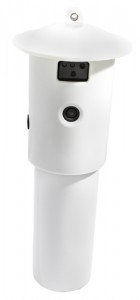Agricultural Aerosal Sprayer
The Challenge:
How to build a more cost-effective, durable and energy-efficient agricultural aerosol sprayer suitable for reliable deployment over large crop areas.
For years, aerosol sprayers have been used to distribute pheromones and other chemicals for pest abatement in agricultural crops and orchards. These units were typically large and made of heavy plastic; thus heavy, expensive to maintain, and cost-prohibitive to deploy on a large scale. The sprayer units – which used steel cans to hold the chemicals – were not particularly weather-resistant, and the metal casing and cans would often corrode when exposed to the elements for extended periods of time.
An international biosciences company was for looking a new sprayer to dispense their pheromones for crop protection and pest control in orchards. The sprayer needed to be:
- Light enough to hang from a tree branch without harming the plant itself.
- Durable enough to withstand the rigors of continued outdoor exposure: UV light, weather and fall impacts.
- Inexpensive, so it could be economically deployed by the hundreds, over vast crop areas.
- Easily adjustable, for quick payload delivery adjustments when needed.
- Reliable enough to continuously operate through an entire season with very limited human interaction.
The Solution
 Working closely with our partners, Bellatrix Systems delivered a recyclable aerosol sprayer unit and control system – a breakthrough in agricultural sprayer technology.
Working closely with our partners, Bellatrix Systems delivered a recyclable aerosol sprayer unit and control system – a breakthrough in agricultural sprayer technology.
- We developed a new smaller, lighter sprayer housing made from advanced plastics that are lightweight, UV and weather-resistant, as well as rugged enough to withstand falling from the trees.
- Utilizing low-powered electronics designs, each sprayer uses only four AA batteries for long-lasting operation—easily operating for an entire season on one set of batteries.
- Working closely with a long-time partner in Asia, we designed a new, lighter-weight, corrosion-resistant, extruded-aluminum can for holding the sprayer payloads to replace the old steel ones.
- We integrated an easy-to-operate and secure patented locking mechanism into the base of each sprayer unit to facilitate replacement of the cans that hold the pheromones or other spray substances.
- A new programmable temperature sensor controls the unit as temperatures fluctuate, allowing for a more efficient application of the chemicals.
In addition to improving the sprayer unit itself, we also developed a patent-pending way to deploy and manage many sprayers at once over large areas. This innovative new technology allows one sprayer to be connected to a control PC for initial set-up. Then, that sprayer unit can act as a control unit (master) to rapidly program additional units (slaves) either before or after placement in the field.
Our patent-pending, networking-capable system incorporates:
- The durable plastic dispenser units.
- Custom PC software to program/control the sprayer payload functions (frequency, timing and amount).
- A USB dongle that facilitates the communication between the PC and the sprayer unit. Infrared (IR) technology allows the control PC to communicate with the sprayer unit, and the sprayer units to communicate with each other.
To successfully develop the different components required to make the systems work together, our in-house hardware and software engineering team utilized ‘cross-functional pair programming’ techniques which we have been pioneering.
The Outcome
The result is a cutting-edge, remote-controlled pheromone dispensing system:
- The rugged, inexpensive, yet extremely reliable aerosol spraying devices can hang from trees and effectively dispense pheromones around the clock for an entire growing season. Because they are recyclable and inexpensive to produce, long-term maintenance is no longer an issue.
- It is quick and easy to replace spray substances, allowing payload containers to be changed in the field with little effort.
- An entire ‘intelligent’ sprayer network can be more easily set up and managed over a large area. A worker in the field can program and modify the units quickly, reducing implementation time and increasing efficiency and consistency.
Services
Technologies
- Advanced plastics engineering
- Low-power device
- Infrared (IR) communications
- Aerosol Sprayer






